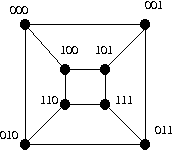
|

|

|

|

|

|

| ||
| G1 | G2 | G3 |
G1: a and b.
G2: a.
G3: r and b..
G1: be
G2: ac
G3: rb
G1: {r, a, b}, {a, c, d}, {b, e}.
G2: {r, a, b, d, e}, {a, c}.
G3: {r, a, c}, {b, d, e}, {r, b}.
Since blocks can intersect in at most one articulation point, There are from 0 to 3 cut vertices. (Draw the pictures.)
Let G be a graph with k blocks
B1 . . . Bk.
The total number of points in all the blocks is
Σk i=1
n(Bi)
We know that any pair of blocks intersects in at most 1 point,
so there are at most k - 1 points which appear in two
blocks and have been double counted.
So n(G) ≥ [ Σk i=1
n(Bi) ] - k + 1.
But since G is connected there must be a path from any point in one block
to any point in another block, so there must be exactly
k - 1 intersection points.
Thus we have equality.
| If e is a cut edge of a graph then one of the vertices of e is a cut vertex. |
K2
Add "with at least three vertices."
Let G be a graph with at least 3 vertices and let e = uv be a cut edge of G.
Since G is connected and has more than 3 vertices, we have that one of u or v
has degree greater than 1. We suppose that d(u) > 1.
Now since d(u) > 1, and e is a cut edge there is some w ∈ V(G)
with w adjacent to v and u and w in different components of G - e.
This means that every uw-patyh goes through v, and so G - v has u and
w in different components.
Thus v is an articulation point of G.

d
P1 = 000, 001, 011
P2 = 000, 010, 011
P3 = 000, 100, 110, 111, 011
P1 = 000, 001, 101
P2 = 000, 010, 110, 100, 101
P3 = 000, 100, 101
Same as part a.
Use this to show that the Peterson graph is 3-connected.

Show that a graph is 2-edge connected if and only if there is a uv-necklace for every pair of vertices u and v.
(⇒)
Let G be a 2-edge connected graph and let u and v be any pair of vertices in V(G).
Now by Menger's Theorem (edge version) there are at least two edge disjoint
uv-paths, P and Q.
Each time P and Q share a point they create a cycle.
Sharing many points creates a necklace.
(⇐)
Let G be a graph for which every pair of vertices u and v
is joined by a uv-necklace.
This means that every pair of points is joined by 2 edge disjoint paths
and so G is 2-edge connected by Mengers Theorem (edge version).
-->